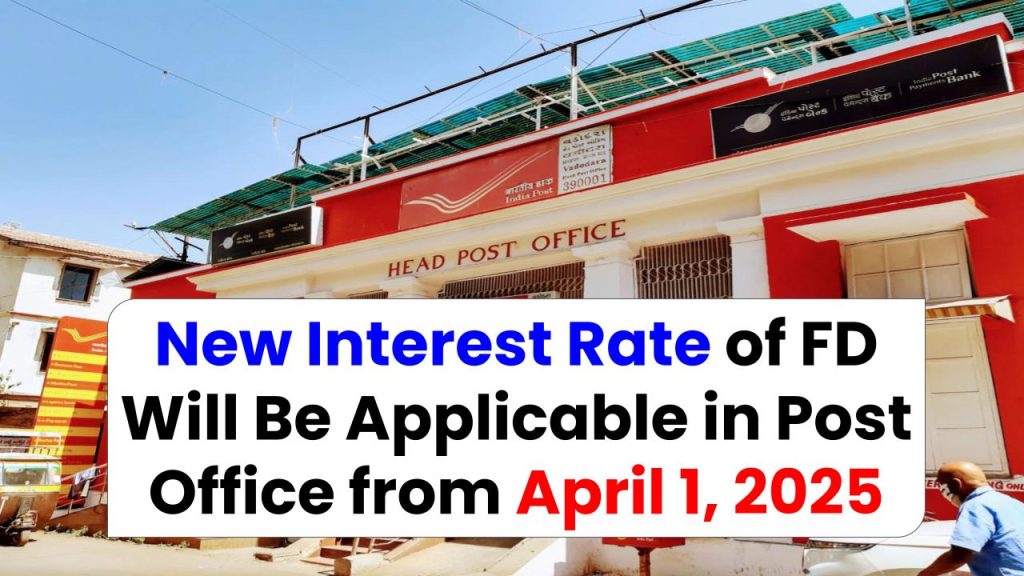
If you’re planning to invest your savings safely and earn steady returns, there’s good news coming from India Post. The Post Office Fixed Deposit interest rate has been revised starting April 1, 2025, and the new rates are now officially in effect. Whether you’re a first-time investor, a retired senior citizen, or a working professional looking to grow your savings securely, Post Office FDs offer a trusted and government-backed option.
With quarterly compounding, tax-saving benefits, and updated returns, these small savings schemes are gaining popularity again. Let’s break down what’s changed, how much you can earn, and whether this is the right investment option for you.
Post Office Fixed Deposit Interest Rate
| Feature | Details (Effective April 1, 2025) |
|---|---|
| 1-Year FD Interest Rate | 6.9% p.a. |
| 2-Year FD Interest Rate | 7.0% p.a. |
| 3-Year FD Interest Rate | 7.1% p.a. |
| 5-Year FD Interest Rate | 7.5% p.a. (Tax-saving under Sec 80C) |
| Minimum Deposit | ₹1,000 |
| Maximum Deposit | No limit |
| Interest Type | Compounded quarterly, paid annually |
| Premature Withdrawal | Allowed after 6 months (with conditions) |
| Tax Benefit | 5-year FD eligible under Section 80C |
| Official Website | India Post Savings Schemes |
If your goal is to protect capital, earn steady returns, and enjoy peace of mind, then a Post Office FD is a smart and secure investment choice. The new interest rates from April 1, 2025, especially the 7.5% for 5-year FDs, make it highly competitive in today’s market. It’s especially useful for those who want government-backed savings, tax benefits, and zero risk.
Post Office Fixed Deposit Scheme: A Safe Bet
The Post Office Fixed Deposit (POFD) scheme is a government-backed savings plan operated through the Department of Posts. It offers guaranteed returns, flexibility in deposit periods, and is particularly popular in rural and semi-urban India, where access to banking is limited.
Unlike bank FDs, where rates may vary across institutions, Post Office FDs come with standardized interest rates, reviewed quarterly by the Ministry of Finance.
see also: ATM Fee Hike: Withdrawing Money from ATM Will Be Expensive
Why it Matters in April 2025
Due to changing market conditions and inflation trends, the government has adjusted the interest rates for several small savings schemes. As part of this quarterly review, Post Office FD rates have been revised upward slightly, especially for long-term deposits (5 years), making it an attractive option for conservative investors.
Post Office Fixed Deposit Interest Rates
1-Year Fixed Deposit – 6.9%
Ideal for short-term savers who want quick returns without taking risks. If you deposit ₹1 lakh, you will receive approximately ₹6,900 as interest annually.
2-Year Fixed Deposit – 7.0%
Great for people who are saving for medium-term goals like travel or educational fees. A ₹2 lakh deposit can fetch you ₹14,000 annually.
3-Year Fixed Deposit – 7.1%
Perfect for creating a savings buffer. For example, a ₹5 lakh FD will yield ₹35,500 in interest annually.
5-Year Fixed Deposit – 7.5%
This is the best value FD as it comes with a tax benefit under Section 80C of the Income Tax Act. On ₹10 lakh investment, you can earn ₹75,000 annually—and claim up to ₹1.5 lakh as a deduction under 80C.
Step-by-Step Guide to Invest in Post Office FD
Step 1: Choose the Tenure
Decide your investment duration: 1, 2, 3, or 5 years based on your financial goal.
Step 2: Open an Account
Visit your nearest post office or apply through the India Post mobile app or online banking portal (if available in your region).
Step 3: Deposit the Money
The minimum amount is ₹1,000, and there’s no maximum limit. You can deposit via cash, cheque, or account transfer.
Step 4: Get the Certificate
You’ll receive an FD certificate or passbook indicating the amount, tenure, and interest rate.
Step 5: Reinvestment or Withdrawal
At maturity, choose to reinvest or withdraw the amount. Reinvested FDs get interest based on the rate applicable at that time.
How Post Office FD Compares to Bank FDs in April 2025
| Feature | Post Office FD | Bank FD (Avg.) |
|---|---|---|
| Backed by Government | Yes | No (varies by bank) |
| Tax Benefit (5-year term) | Yes (Sec 80C) | Yes |
| Interest Rate (5-Year) | 7.5% | 6.75% – 7.25% |
| Premature Withdrawal | After 6 months | Often after 3 months |
| Online Access | Limited | Widely available |
Verdict: Post Office FDs are more secure and currently offer slightly better rates, especially for long-term investors.
Pros and Cons of Investing in Post Office FD
Pros
- 100% risk-free investment backed by the Government of India
- Better rates than many bank FDs as of April 2025
- Ideal for senior citizens, first-time investors, and those in Tier 2 or rural areas
- Tax benefits under Section 80C for 5-year tenure
Cons
- Limited online services compared to private banks
- Interest is taxable (unless exempt under specific provisions)
- Not suitable for high-risk, high-return seekers
Real-Life Example: How Much Will You Earn?
Let’s say you invest ₹5,00,000 for 5 years in a Post Office FD:
- Interest Rate: 7.5%
- Annual Interest: ₹37,500
- Total Interest in 5 Years: ₹1,87,500
- Maturity Amount: ₹6,87,500
And if you claim Section 80C benefits, you also save tax on up to ₹1.5 lakh of your investment!
see also: Deposit ₹ 2 Lakh in Bank of Baroda’s Scheme and Get Fixed Interest of ₹ 17,902
Post Office Fixed Deposit FAQs
1. Can I open a Post Office FD online?
Currently, online FD booking is limited. However, some post offices offer digital services through India Post Payments Bank (IPPB).
2. Is there any TDS deduction on Post Office FD interest?
Yes, interest is taxable as per your income slab. No TDS is deducted at source unless PAN is not provided.
3. Can NRIs invest in Post Office FDs?
No, Non-Resident Indians (NRIs) are not allowed to open or invest in Post Office FD schemes.
4. What happens on maturity if I don’t withdraw the FD?
If you don’t withdraw, the FD will be automatically renewed for the same tenure at the rate applicable at that time.
5. Can I take a loan against my Post Office FD?
No, loans against Post Office FDs are not allowed, unlike some bank FDs.











